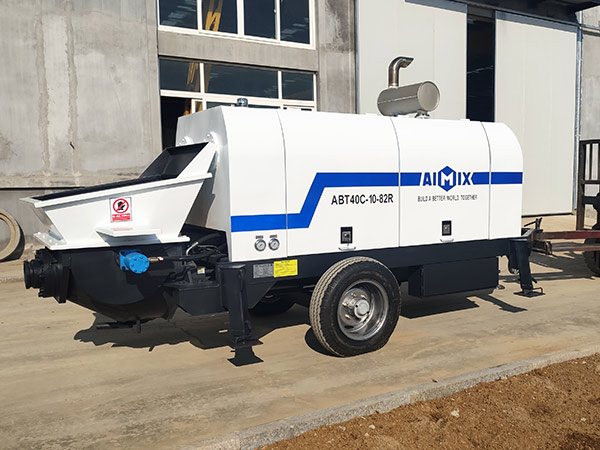Concrete is the lifeblood of modern construction, forming the backbone of everything from towering skyscrapers to intricate bridges. In the orchestration of such grand endeavors, the methods of transporting and placing concrete are as critical as the concrete itself. Enter the concrete pump stationary – a marvel of engineering that has revolutionized how we approach large-scale, complex construction projects. With its unmatched efficiency and versatility, the stationary concrete pump is the unsung hero of construction sites worldwide.
Efficiency and Precision in Concrete Placement
Streamlined Workflow
The stationary concrete pump offers a seamless, streamlined workflow that minimizes delays and maximizes productivity. Unlike traditional methods that rely heavily on manual labor and are subject to the whims of weather and human error, stationary pumps deliver concrete consistently and precisely where it’s needed. By eliminating the need for time-consuming transportation and manual handling, these pumps drastically reduce the risk of bottlenecks and delays, ensuring that construction schedules stay on track.
The pump’s ability to handle high volumes of concrete with pinpoint accuracy also means fewer interruptions. This uninterrupted flow allows construction crews to work more efficiently, reducing downtime and increasing the overall speed of the project. In a world where time is money, this efficiency translates directly into cost savings and project viability.

Enhanced Control and Accuracy
Control and accuracy are paramount in construction, and stationary concrete pumps excel in both. With advanced pumping mechanisms and adjustable settings, these concrete pumping machines can precisely control the flow rate and pressure of the concrete, ensuring it is placed exactly as needed. This level of control minimizes waste, prevents over-pouring, and reduces the need for costly corrections later on.
Furthermore, the precision of stationary pumps allows for the construction of intricate designs and complex structures that would be difficult, if not impossible, to achieve with traditional methods. Whether it’s the delicate curves of an architectural masterpiece or the precise alignment of structural components, stationary concrete pumps provide the accuracy needed to bring ambitious designs to life.
Versatility in Construction Applications
Adaptability to Various Projects
One of the standout features of stationary concrete pumps is their remarkable adaptability. From high-rise buildings to expansive dams, these pumps can be configured to meet the specific demands of virtually any construction project. Their ability to handle a wide range of concrete types, including high-strength and lightweight varieties, makes them indispensable tools for diverse applications.
In large-scale projects such as tunnels and bridges, where the delivery of concrete to hard-to-reach areas is a significant challenge, stationary pumps prove their worth. They can pump concrete horizontally and vertically over great distances, overcoming obstacles and ensuring that even the most remote sections of a project receive a steady supply of concrete. This adaptability not only simplifies logistics but also enhances the feasibility of complex construction endeavors.

Compatibility with Advanced Technologies
In the era of digital construction and smart technologies, stationary concrete pumps are not left behind. They seamlessly integrate with modern construction management systems, providing real-time data on performance, concrete quality, and other critical parameters. This compatibility allows project managers to make informed decisions, optimize operations, and ensure the highest standards of quality and safety. You can check the advanced technologies on AIMIX concrete pumps.
The use of advanced technologies such as GPS and remote control further enhances the functionality of stationary pumps. Operators can monitor and control the pumps from a distance, improving safety and efficiency on the job site. This technological synergy positions stationary concrete pumps at the forefront of innovation in construction machinery.
Contribution to Sustainability and Safety
Reduction of Environmental Impact
Sustainability is a growing concern in the construction industry, and stationary concrete pumps contribute positively in this regard. By enabling precise placement of concrete, these pumps minimize waste and reduce the consumption of materials. The efficiency of stationary pumps also translates into lower energy usage, as less machinery and fewer resources are needed to complete the same amount of work.
Moreover, stationary pumps support the use of environmentally friendly concrete mixtures, including those with recycled materials and lower carbon footprints. This compatibility with green construction practices helps projects meet sustainability goals and reduces the overall environmental impact of large-scale construction activities.
Enhancing Worker Safety
Safety on construction sites is non-negotiable, and stationary concrete pumps enhance it in several ways. By automating the delivery and placement of concrete, these pumps reduce the need for manual handling and the associated risks of injury. The ability to operate the pumps remotely further enhances safety, allowing workers to avoid hazardous areas and focus on other critical tasks. View the concrete pumps’ safety operation on this page: https://aimixconcretesolution.com/concrete-mixer-with-pump/.
Additionally, the precision and control offered by stationary pumps mean fewer accidents caused by over-pouring or unstable structures. With better quality control and fewer errors, the overall safety of the construction process is significantly improved. This emphasis on safety not only protects workers but also contributes to smoother, more efficient project execution.
Conclusion
In the realm of large-scale, complex construction projects, the stationary concrete pump stands as a paragon of efficiency, versatility, and innovation. Its ability to streamline workflows, enhance precision, and adapt to diverse applications makes it an indispensable tool for modern construction. Beyond improving productivity and reducing costs, stationary concrete pumps contribute to sustainability and safety, aligning with the evolving demands of the industry. As we continue to push the boundaries of architectural and engineering possibilities, the stationary concrete pump will undoubtedly remain a cornerstone of progress.